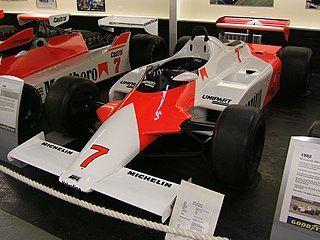An aromatic hydrocarbon or arene is a hydrocarbon with sigma bonds and delocalized pi electrons between carbon atoms forming a circle. In contrast, aliphatic hydrocarbons lack this delocalization. The term "aromatic" was assigned before the physical mechanism determining aromaticity was discovered, and referred simply to the fact that many such compounds have a sweet or pleasant odour; however, not all aromatic compounds have a sweet odour, and not all compounds with a sweet odour are aromatic. The configuration of six carbon atoms in aromatic compounds is called a "benzene ring", after the simplest possible such hydrocarbon, benzene. Aromatic hydrocarbons can be monocyclic (MAH) or polycyclic (PAH).

A carboxylic acid is an organic compound that contains a carboxyl group attached to an R-group. The general formula of a carboxylic acid is R–COOH, with R referring to the alkyl group. Carboxylic acids occur widely. Important examples include the amino acids and fatty acids. Deprotonation of a carboxylic acid gives a carboxylate anion.

In organic chemistry, functional groups are specific substituents or moieties within molecules that are responsible for the characteristic chemical reactions of those molecules. The same functional group will undergo the same or similar chemical reaction(s) regardless of the size of the molecule it is a part of. This allows for systematic prediction of chemical reactions and behavior of chemical compounds and design of chemical syntheses. Furthermore, the reactivity of a functional group can be modified by other functional groups nearby. In organic synthesis, functional group interconversion is one of the basic types of transformations.

In chemistry, particularly in biochemistry, a fatty acid is a carboxylic acid with a long aliphatic chain, which is either saturated or unsaturated. Most naturally occurring fatty acids have an unbranched chain of an even number of carbon atoms, from 4 to 28. Fatty acids are usually not found in organisms, but instead as three main classes of esters: triglycerides, phospholipids, and cholesteryl esters. In any of these forms, fatty acids are both important dietary sources of fuel for animals and they are important structural components for cells.

Fats are one of the three main macronutrients, along with carbohydrates and proteins. Fat molecules consist of primarily carbon and hydrogen atoms and are therefore hydrophobic and are soluble in organic solvents and insoluble in water. Examples include cholesterol, phospholipids, and triglycerides.
Monosaccharides, also called simple sugar, are the simplest form of sugar and the most basic units of carbohydrates. They cannot be further hydrolyzed to simpler chemical compounds. The general formula is C
nH
2nO
n. They are usually colorless, water-soluble, and crystalline solids. Some monosaccharides have a sweet taste.

Steel is an alloy of iron and carbon and, sometimes, other elements such as chromium. Because of its high tensile strength and low cost, this material is best used in buildings, infrastructure, tools, ships, trains, cars, machines, electrical appliances, and weapons. Iron is the base metal of steel and it can take on two crystalline forms : body centred cubic and face-centred cubic. These forms depend on temperature. In the body-centred cubic arrangement, there is an iron atom in the centre and eight atoms at the vertices of each cubic unit cell; in the face-centred cubic, there is one atom at the centre of each of the six faces of the cubic unit cell and eight atoms at its vertices. It is the interaction of the allotropes of iron with the alloying elements, primarily carbon, that gives steel and cast iron their range of unique properties.

In chemistry, a hexose is a monosaccharide (simple sugar) with six carbon atoms. The chemical formula for all hexoses is C6H12O6, and their molecular weight is 180.156 g/mol.

The haloalkanes are a group of chemical compounds derived from alkanes containing one or more halogens. They are a subset of the general class of halocarbons, although the distinction is not often made. Haloalkanes are widely used commercially and, consequently, are known under many chemical and commercial names. They are used as flame retardants, fire extinguishants, refrigerants, propellants, solvents, and pharmaceuticals. Subsequent to the widespread use in commerce, many halocarbons have also been shown to be serious pollutants and toxins. For example, the chlorofluorocarbons have been shown to lead to ozone depletion. Methyl bromide is a controversial fumigant. Only haloalkanes which contain chlorine, bromine, and iodine are a threat to the ozone layer, but fluorinated volatile haloalkanes in theory may have activity as greenhouse gases. Methyl iodide, a naturally occurring substance, however, does not have ozone-depleting properties and the United States Environmental Protection Agency has designated the compound a non-ozone layer depleter. For more information, see Halomethane. Haloalkane or alkyl halides are the compounds which have the general formula "RX" where R is an alkyl or substituted alkyl group and X is a halogen.
A glycosidic bond or glycosidic linkage is a type of covalent bond that joins a carbohydrate (sugar) molecule to another group, which may or may not be another carbohydrate.

A commutator is a rotary electrical switch in certain types of electric motors and electrical generators that periodically reverses the current direction between the rotor and the external circuit. It consists of a cylinder composed of multiple metal contact segments on the rotating armature of the machine. Two or more electrical contacts called "brushes" made of a soft conductive material like carbon press against the commutator, making sliding contact with successive segments of the commutator as it rotates. The windings on the armature are connected to the commutator segments.

A distributor is an enclosed rotating shaft used in spark-ignition internal combustion engines that have mechanically-timed ignition. The distributor's main function is to route secondary, or high voltage, current from the ignition coil to the spark plugs in the correct firing order, and for the correct amount of time. Except in magneto systems and many modern computer controlled engines that use crank angle/position sensors, the distributor also houses a mechanical or inductive breaker switch to open and close the ignition coil's primary circuit.
In chemical nomenclature, the IUPAC nomenclature of organic chemistry is a method of organic chemical compounds as recommended by the International Union of Pure and Applied Chemistry (IUPAC). It is published in the Nomenclature of Organic Chemistry. Ideally, every possible organic compound should have a name from which an unambiguous structural formula can be created. There is also an IUPAC nomenclature of inorganic chemistry.
In organic chemistry and biochemistry, a substituent is an atom or group of atoms which replaces one or more hydrogen atoms on the parent chain of a hydrocarbon, becoming a moiety of the resultant new molecule. The terms substituent and functional group, as well as other ones are used almost interchangeably to describe branches from a parent structure, though certain distinctions are made in the context of polymer chemistry. In polymers, side chains extend from a backbone structure. In proteins, side chains are attached to the alpha carbon atoms of the amino acid backbone.

Thioxanthene is a chemical compound in which the oxygen atom in xanthene is replaced with a sulfur atom. It is also related to phenothiazine. Several of its derivatives are used as typical antipsychotics in the treatment of schizophrenia and other psychoses.

The McLaren MP4/1 was a Formula One racing car produced by the McLaren team. It was used during the 1981, 1982 and 1983 seasons. It was the first Formula One car to use a monocoque chassis wholly manufactured from carbon fibre composite, a concept which is now ubiquitous.

The 2009 HiQ MSA British Touring Car Championship season was the 52nd British Touring Car Championship (BTCC) season. It began at Brands Hatch on the Indy layout on 5 April and finished after 30 races over 10 events on the Grand Prix layout at Brands Hatch on 4 October. Colin Turkington won the championship for the first time, ahead of Jason Plato and Fabrizio Giovanardi.
Monosaccharide nomenclature is the naming conventions of the basic unit of carbohydrate structure, monosaccharides, which may be monomers or part of a larger polymer. Monosaccharides are subunits that cannot be further hydrolysed in to simpler units. Depending on the number of carbon atom they are further classified in to trioses, tetroses, pentoses, hexoses etc., which is further classified in to aldoses and ketoses depending on the type of functional group present in them.

Buphedrone, also known as α-methylamino-butyrophenone (MABP), is a stimulant of the phenethylamine and cathinone chemical classes that was first synthesized in 1928. It is legal in most countries as a research chemical, as long as it is not intended for human consumption.

Altered Carbon is an American cyberpunk web television series created by Laeta Kalogridis and based on the 2002 novel of the same title by English author Richard K. Morgan. In a world where consciousness can be transferred to different bodies, Takeshi Kovacs, a former soldier turned investigator, must solve a murder. The first season consists of ten episodes and premiered on Netflix on February 2, 2018. On July 27, 2018, the series was renewed for a second season of eight episodes, which was released on February 27, 2020, with an anime film set before the first season released on March 19, 2020. The series received generally positive reviews.














